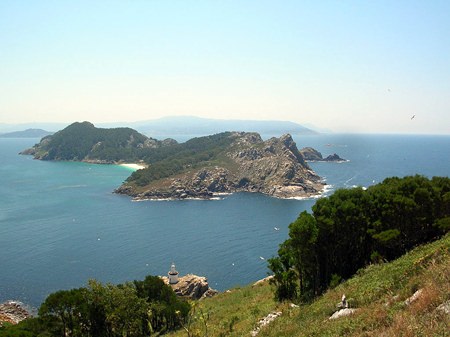And so to Spain. It’s the most widely planted wine-producing nation in the world and in sheer quantity of wine produced it’s up there in the top three. I’m sure you know what the other two countries are. Even my dogs know the answer to that. What many people don’t know is that Spain has at least four hundred native grape varieties and could even have as many as seven or eight hundred. No one seems to know for sure but in reality, most Spanish wines are made from only about twenty of grape varieties. While the most well-known Spanish wine is probably Sherry, there are countless table wines made there. Interestingly, Spain also produces nearly half of all the olive oil in the world.
Although many of the “international” grapes are grown in Spain, to my mind it’s the local varieties that produce the most interesting wines. So this week, let’s look at two wines made from indigenous grapes that couldn’t be more different in character. One comes from the northwest coast of Spain where the cold grey waves of the Atlantic Ocean meet the rugged coastline. The other is made from grapes grown in vineyards nearly six hundred miles to the south, near the coast of the Mediterranean Sea where in the summer the blazing sun literally bakes the earth in the vineyards.
 The rocky coast of Rias Baixas
The rocky coast of Rias Baixas
The Albariño (al-baa-REE-nyo) is a green-skinned grape variety native to Galicia on the Atlantic coast just north of Portugal. The grape is popular in Portugal too, where it’s known as Alvarinho and is one of the varieties used to make the famous Vinho Verde. Wines made from Albariño have bags of acidity and fresh aromas of peach, apricot and jasmine and they’re nearly always lively, refreshing and minerally. The Rias Baixas (REE-ahs BAI-shass) region of Galicia is mostly planted with Albariño and if you want to try a splendid example, looks no further than this one. The price tag might look a bit daunting, but quality wines from old-established family wineries rarely come cheap. In any case, this wine is excellent value.
Zarate Albariño Rias Baixas 2013 (white), Spain (Bt. 1,100 @ Wine Garage)
Let’s first decode the label. Zarate is the wine company. It’s a family property located in the heart of Valle del Salnés district of Galicia. The company has been in the same family for seven generations and its origins can be traced back to the early years of the eighteenth century. Rías Baixas is a coastal wine region which produces some of the country’s most acclaimed dry whites. And in case you’re wondering, the name means “lower estuaries”. This wine is a pale straw colour, bright and oily-looking. There’s a floral aroma of green apples, pomelo and peaches with creamy overtones. The flavours are sharply focused and the mineral notes are unmistakable. There’s a good dollop of acidity and in some ways the wine reminds me of Chablis in character but there’s somehow a whiff of the sea. On the palate there are touches of peach and apricot in this intense, steely wine and it has a persistent citrus finish which gradually fades gently into the background.
This is a text-book Albariño and as you might have guessed, it would be at its best with food, especially food from the sea. But Albariño also refreshes and cools the palate, making it ideal for spicy dishes including Indian, Chinese, Thai, and Vietnamese food. It would make a good partner for many chicken dishes, lobster, octopus or mussels.
Barahonda Barrica 2011 (red), Spain (Bt. 890 @ Wine Garage)
Spain’s historical seaside town of Alicante lies right on the Mediterranean and it’s one of the ferry terminals for the Balearic Islands and North Africa. If you were to drive out of town on the A-31 then turn left on to the CV-81 at Villena, a short drive would bring you into the town of Yecla. They’ve been growing vines in the region for over two thousand years and in these parts the winter temperature can drop to -6°C, while in summer there’s often a daytime temperature of 40°C. With more than three thousand hours of sun per year, it’s an ideal climate for Monastrell, a Spanish grape variety first documented in the fifteenth century and known in France as Mourvédre. It produces tannic wines which are high in alcohol.
Barahonda Barrica is an estate-bottled wine made by Señorio de Barahonda, the oldest winery in the Yecla region. It combines the powerful Monastrell with the softer and spicy Syrah, produced in a state-of-the-art winery surrounded by hundred-year-old vines. The wine is a bright cherry-red and there’s a rich aroma of mature black fruit with hints of oak, because the wine was aged in French oak barrels for six months. The Spanish word barrica incidentally, means “barrel”. At 14.5% ABV this is a big wine, full-bodied and as dry as they come, with a pleasing touch of acidity. There’s plenty of fruit on the palate creating an illusion of sweetish overtones. The tannins are soft and firm giving the wine a good sense of structure. Even so, like many other quality wines, it really needs some time to open up. If you pour out a glassful from a newly-opened bottle the taste will probably seem tight and closed. Give it a bit of air and it will open up like a flower revealing more fruit and softer tannins.
Both these wines can be ordered online from Wine Garage, a Bangkok-based company which specialises in artisanal wines. You can pay by bank transfer or PayPal, which makes things ever so easy. They’ll deliver anywhere in Thailand and the QR code shown will take you to their fascinating website.
Incidentally, this wine has won bucket-loads of international awards and this vintage was given 92 points by Robert Parker. It could make a good companion to grilled or roast pork, tandoori chicken, rich veal dishes or rabbit. Or so I am told. And by the way, when the Carthaginians came to the country around 300 BC, they called it Ispania, which eventually became España. It apparently means “land of the rabbits”.




